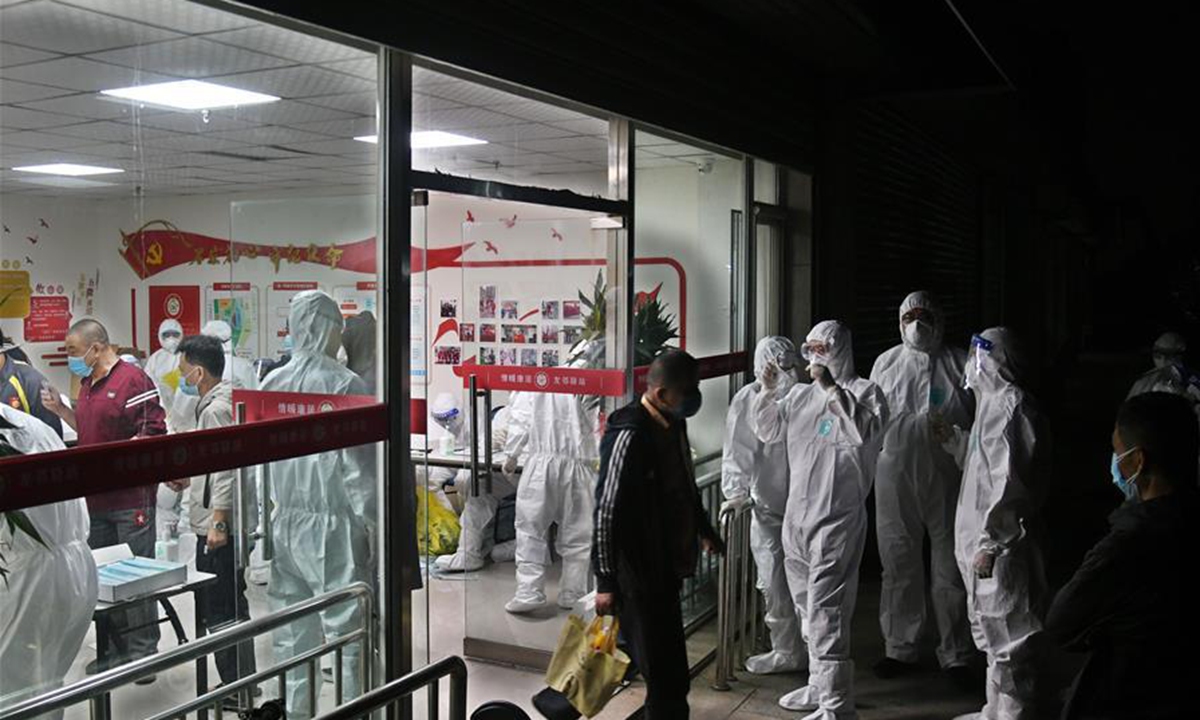Update: Over one third of 9 million people tested in Qingdao, no new cases found
By Liu Caiyu Source: Global Times Published: 2020/10/13 0:10:24 Last Updated: 2020/10/13 10:10:24
Qingdao to test 9m in 5 days despite ‘low risk’ of COVID-19 wide spread

Local residents take nucleic acid tests in Shibei District, Qingdao, East China's Shandong Province on October 11. Photo: Xinhua
After a small cluster of COVID-19 infections was detected, the tourist city of Qingdao in East China's Shandong Province became a new battleground against the coronavirus, having received over 4.47 million visitors during the National Day holidays. However, health experts said the risk of the flare-up in Qingdao spreading to other parts of China is relatively low.
The coastal city is racing against time to carry out city-wide nucleic acid tests. The target is to test about 6 million people from five districts by Tuesday, and roughly 9 million people will be tested in five days. So far six confirmed cases have been reported, along with another six asymptomatic cases.
As of Tuesday morning, a total of 3.07 million people in Qingdao had received nucleic acid tests and no new COVID-19 cases were found, the local health authority reported Tuesday.
A total of 144 close contacts were tracked and quarantined with all results coming back negative. More than 170,867 people from local hospitals — patients, medical staff and nurses — and 2.9 million from communities were also tested.
Loushanhou community, where the Qingdao Chest Hospital, a designated hospital for COVID-19 patients from overseas, is located and where the new cluster of COVID-19 infection was discovered, was upgraded to a medium-risk area, local officials announced on a Monday press conference.
Residential communities, hospitals and markets where the cases have been detected are all sealed off, the Qingdao government announced.
The risk of Qingdao's COVID-19 flare-up is small as it was found in a hospital instead of within the community, and the cases were transferred immediately to hospitals, said a local official.
Shandong is going all-out to support Qingdao. The provincial government set up a headquarters in Qingdao to arrange epidemic work in the city. The National Health Commission also dispatched a working team on Monday.
A local resident surnamed Fa, living about 2 kilometers away from the Qingdao Chest Hospital, told the Global Times that Qingdao people reacted rationally to the outbreak as locals had come to regard the novel coronavirus as part of life. On Monday, people went to work, and schools and markets opened as usual, but more people wore masks.
"After the busy National Day holidays, we expect the flow of customers will return to normal," a restaurant owner surnamed Li, told the Global Times. Li said his restaurant opened normally on Monday but fewer people came.
After the new infections emerged, Fa said locals lined up to get tested in communities, some major local companies started to monitor the health of their employees, and schools organized students to be tested. "The citywide nucleic acid testing doesn't mean that there's a terrible epidemic. Qingdao will assure the country through the test," some wrote.
Many local residents swarmed online, calling for people to get tested as soon as possible. "That's the best way to dismiss the virus," some said.
Since the small outbreak came just after the National Day holidays, when Qingdao received more than 4 million travelers, public health experts said there's a risk of the disease spreading wider, but the swift response of the government will make sure the risk is low.
The scope of any possible spread is limited and is confined to people who had connection with the Qingdao Chest Hospital, Wang Peiyu, deputy head of Peking University's School of Public Health, assured the public, saying there's no need to overreact.
Some cities including Beijing and Jinan have sought to identify people who went to the Qingdao in the past 14 days, after Qingdao reported 12 COVID-19 cases. New cases cannot be ruled out in Qingdao as the citywide nucleic acid test is in full swing, observers noted.
The local health authority said all six confirmed COVID-19 cases and six asymptomatic patients had close connections to the Qingdao Chest Hospital.
But the real source of the infections remains unknown. The Qingdao Chest Hospital on Monday dismissed rumors that claimed "incomplete disinfection after CT checks on imported cases caused the spread of the coronavirus."
Yang Zhanqiu, a Wuhan-based virologist, said it is essential to determine the strain of the virus, whether domestic or foreign. If it was found to be domestic, Yang told the Global Times this outbreak probably also exists beyond Qingdao and anti-epidemic measures will need to be adjusted.
Some claimed online that a taxi driver who had been confirmed to be infected actually did not wear a mask while driving, which could have caused infection risks to his passengers. But the taxi driver said he always wears a mask while driving and does not talk to his passengers.
Beijing health authorities are seeking anyone who was in the taxi since September 27.
Since China has been relatively successful in its early fight against the epidemic, there are basically no local transmission cases nationwide, and Qingdao could achieve zero COVID-19 infection by expanded testing, Zhang Wenhong, China's leading infectious disease specialist and head of the Shanghai COVID-19 medical team, said on Monday.
RELATED ARTICLES:
Posted in: SOCIETY